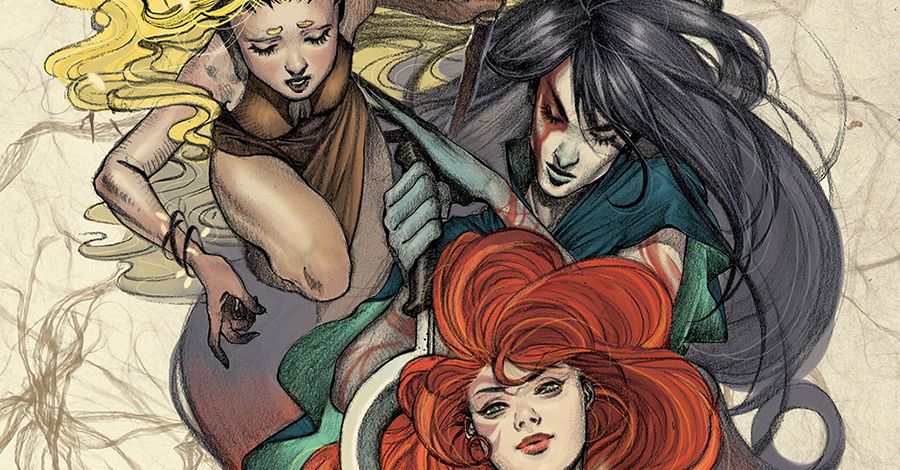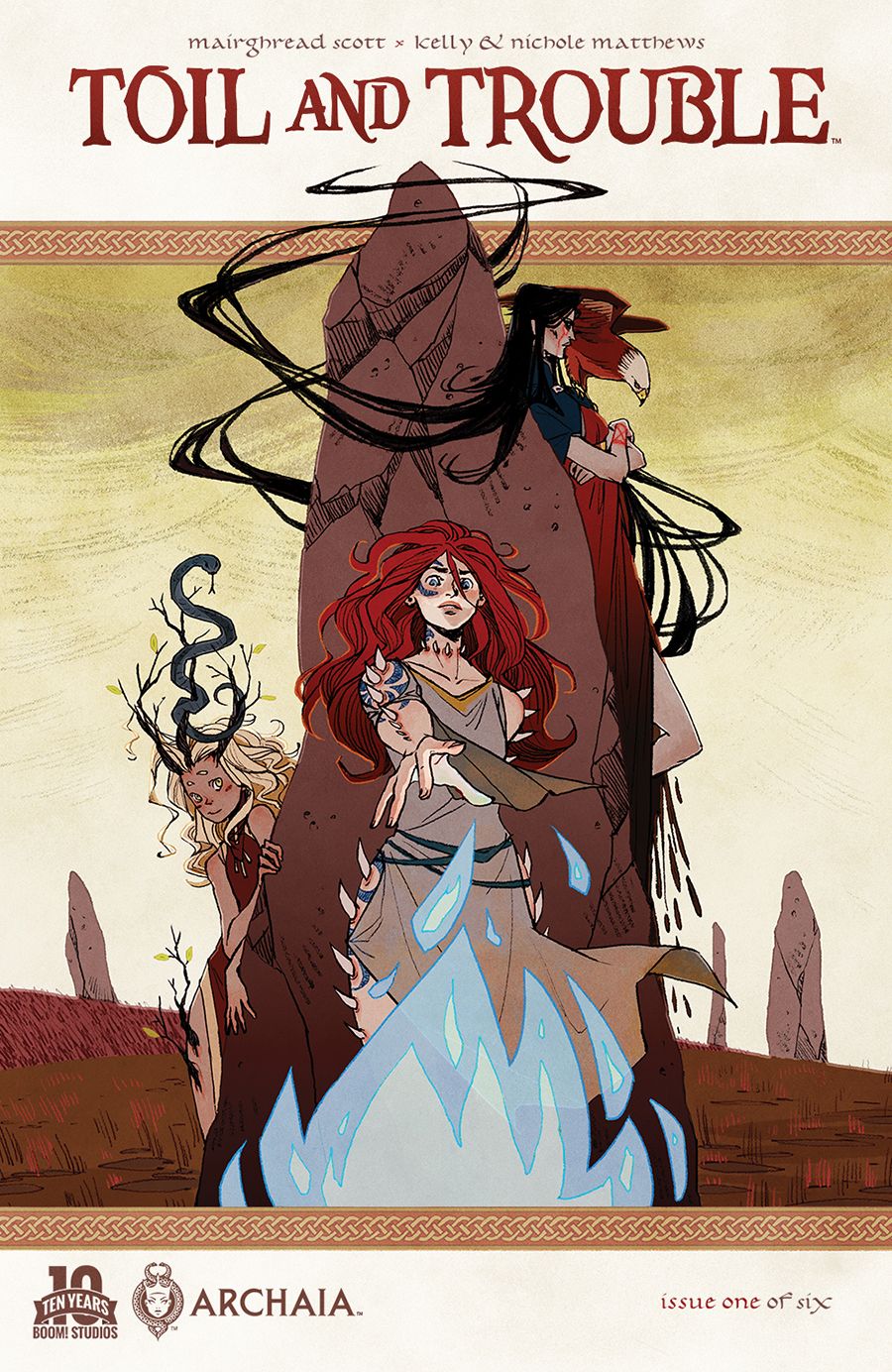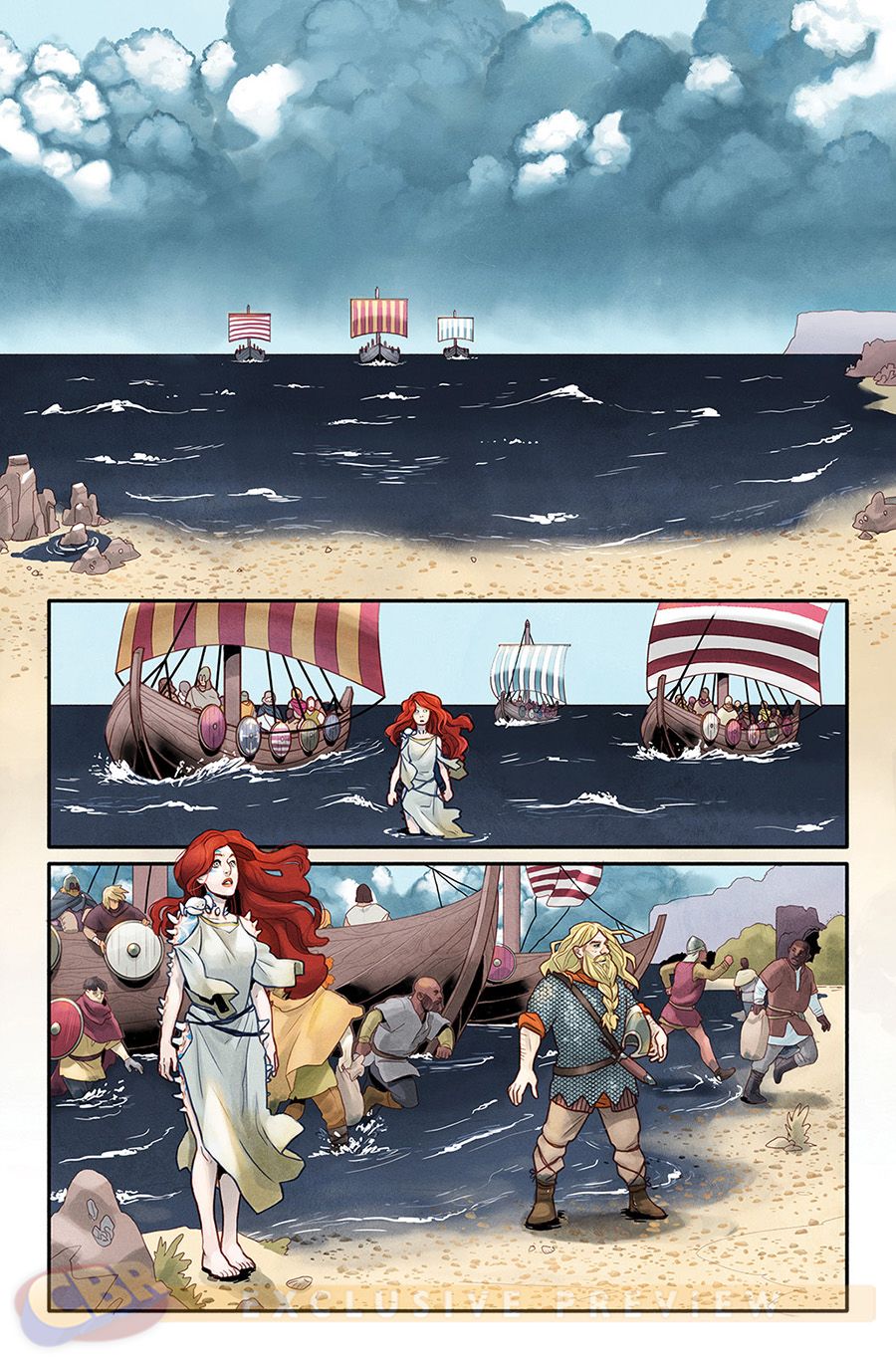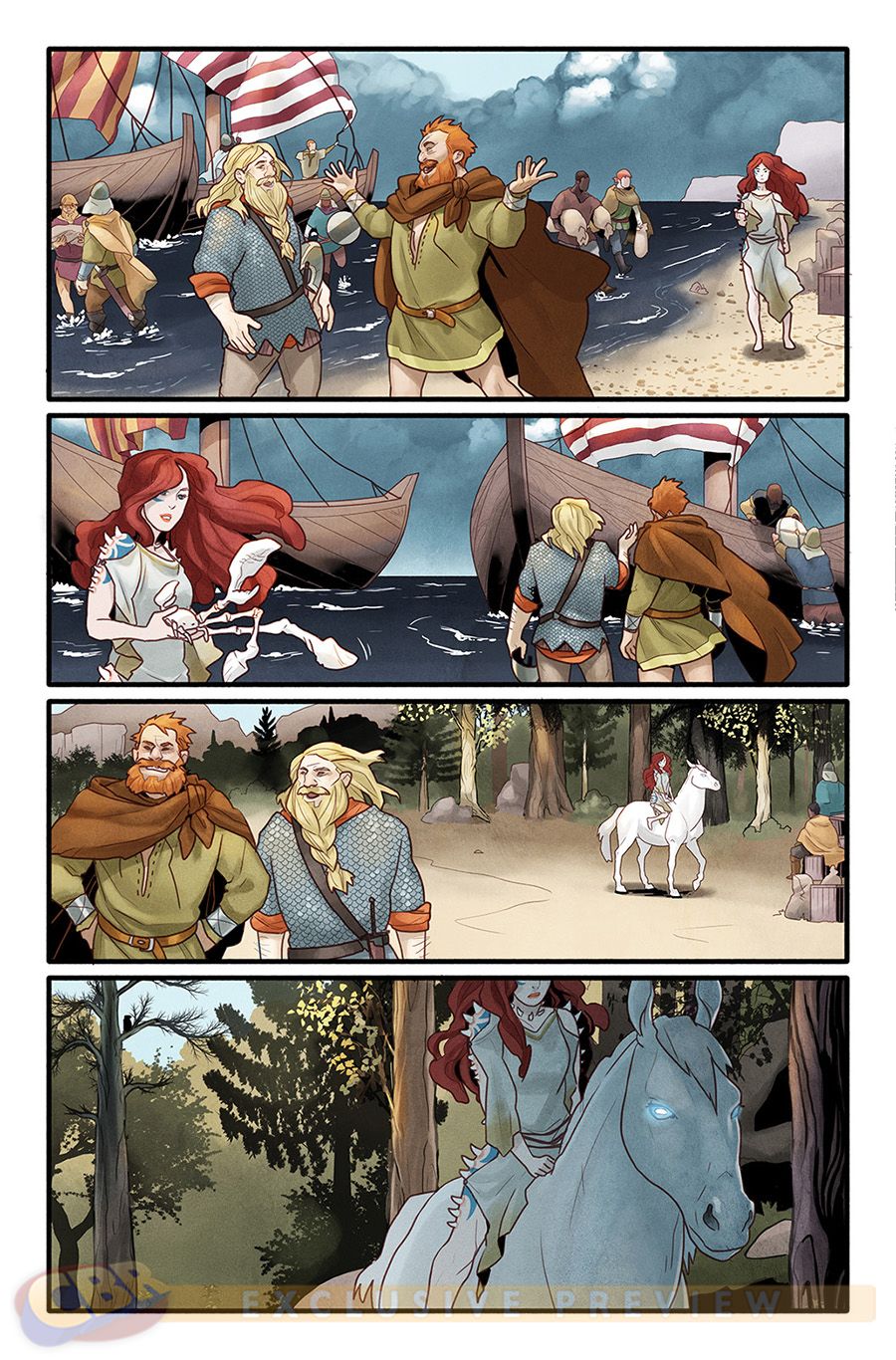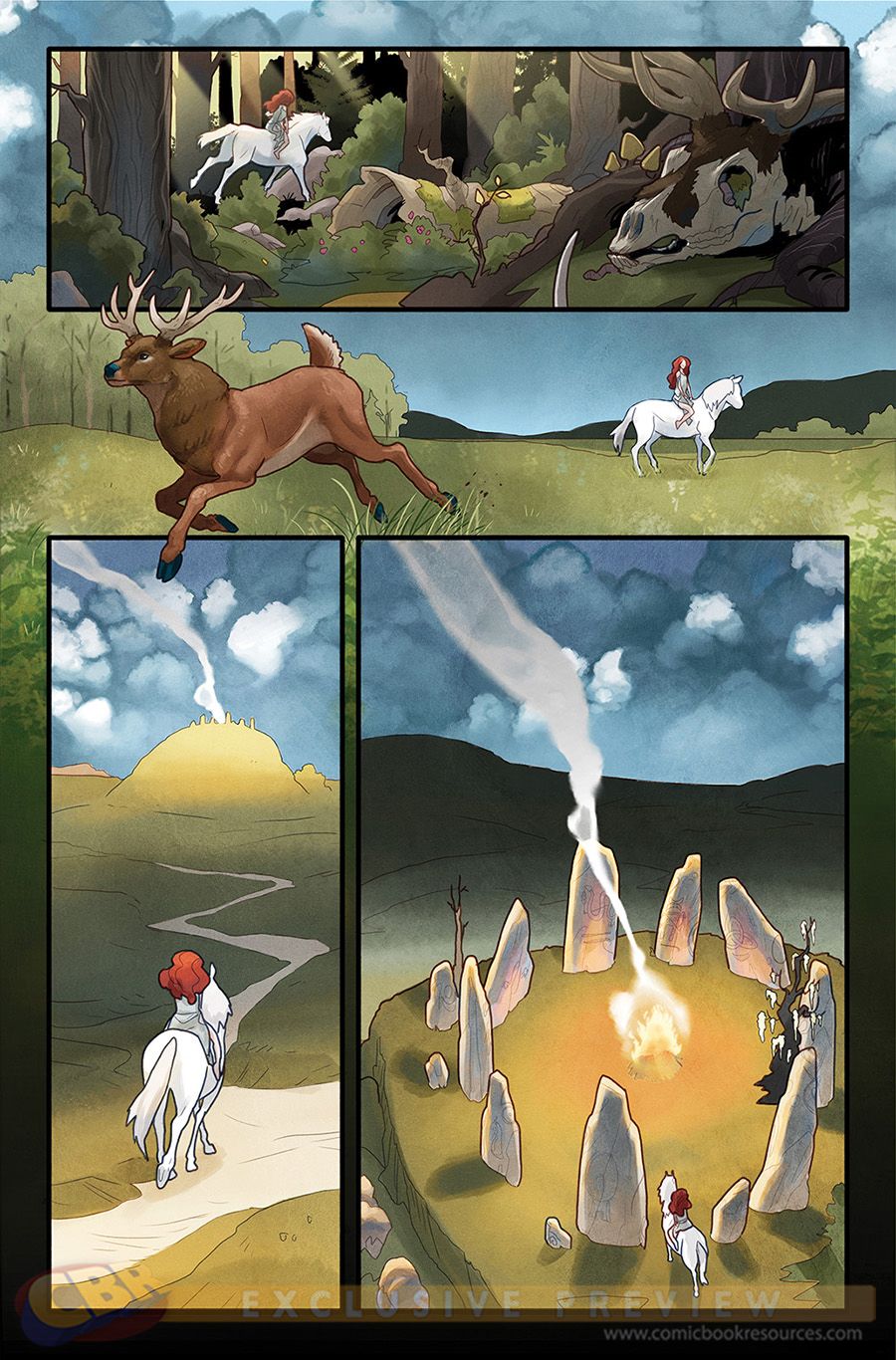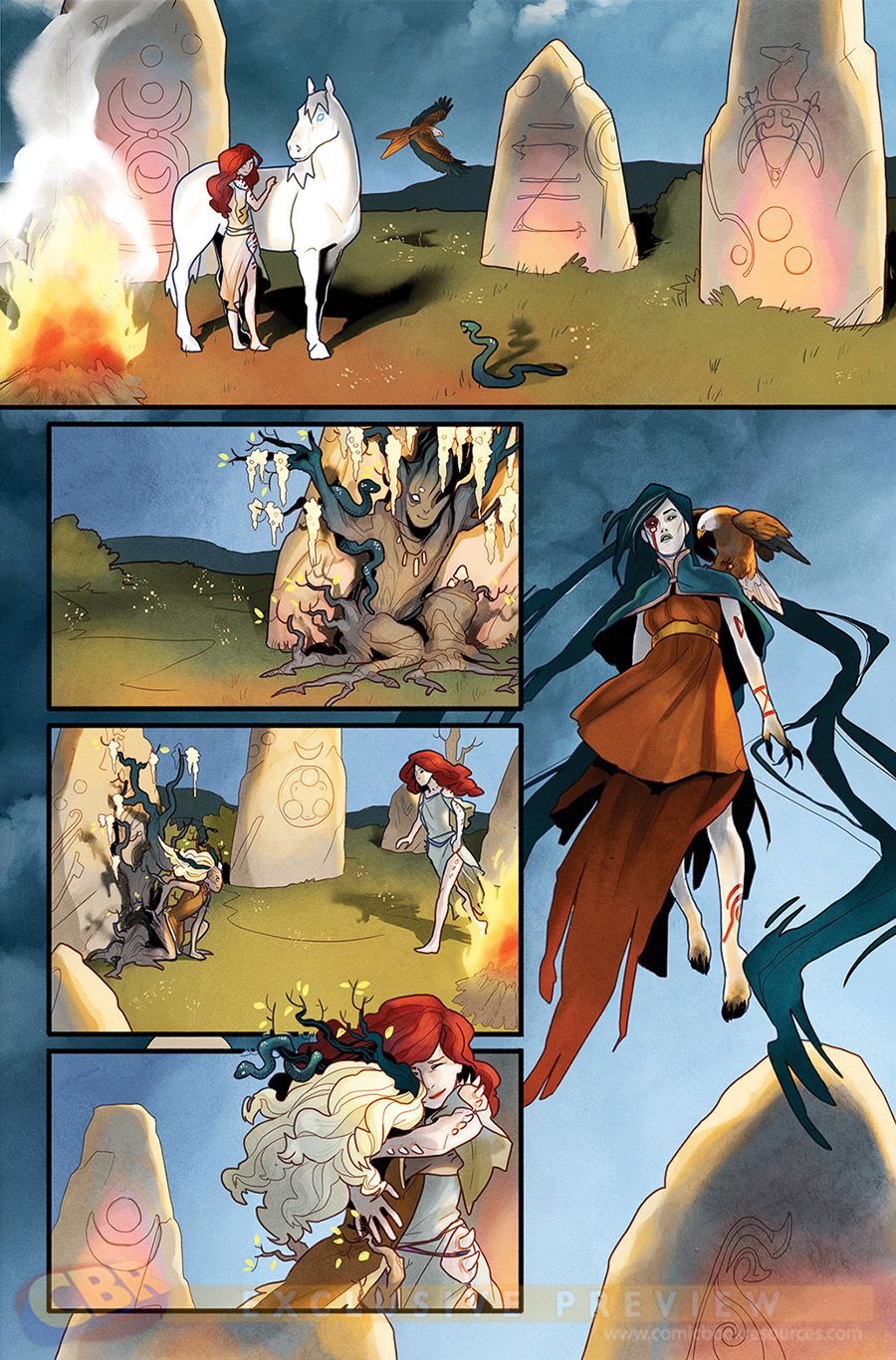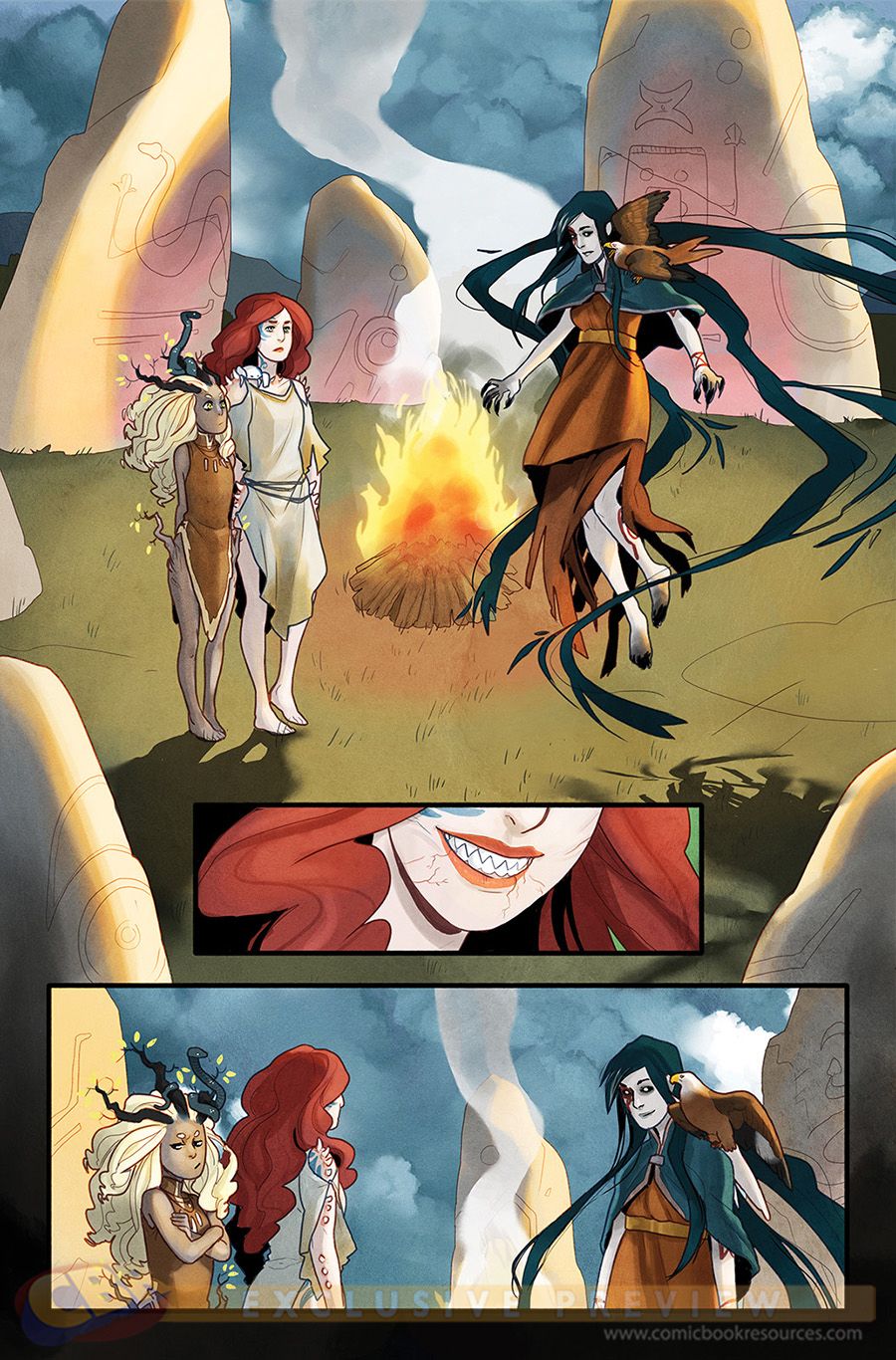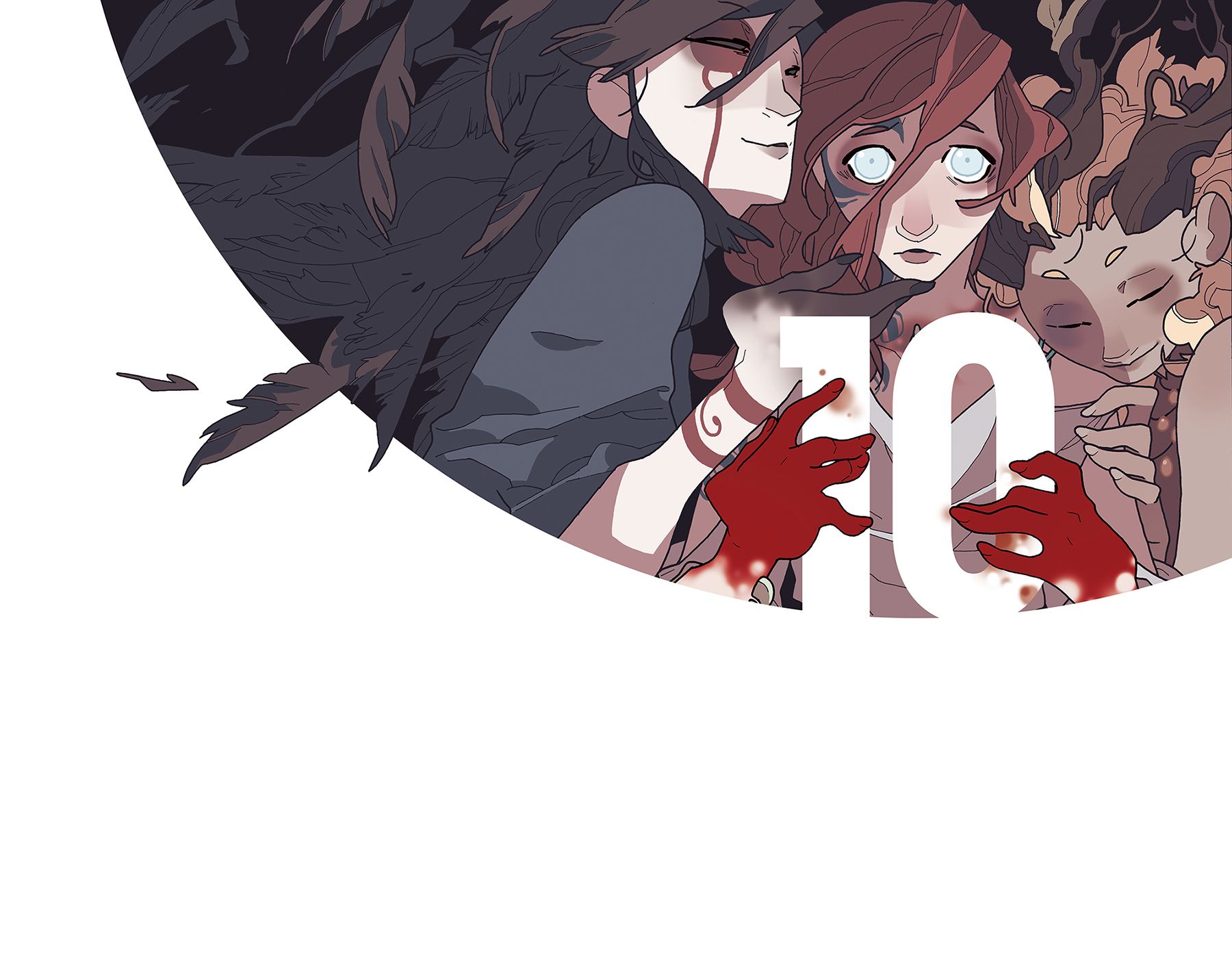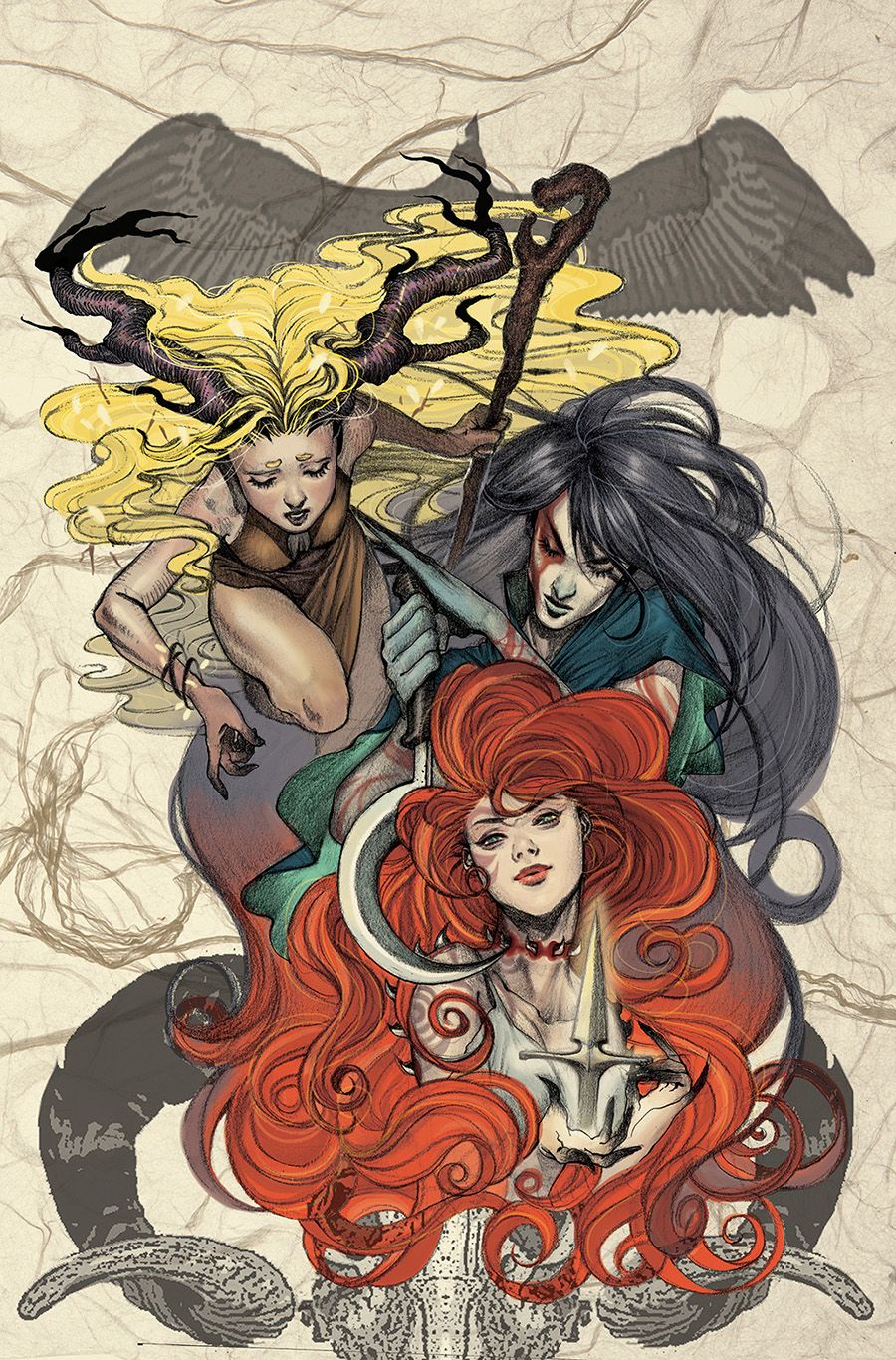Few quotes are more associated with witches than "double, double toil and trouble." The line is uttered by the witches three in William Shakespeare's tragedy "Macbeth" and ranks right up there with "Wizard of Oz's" "I'll get you, my pretty -- and your little dog too" and Willow the witch's creepy black eyes from "Buffy the Vampire Slayer" when it comes to fictional witch iconography. Considering how formative a role the Shakespeare line played in establishing witch lore, it should come as no surprise that a comic based on "Macbeth's" three fates will take center stage in "Toil and Trouble," a six issue series from Archaia launching on September 2.
"Lantern City" and "Transformers: Windblade" writer Mairghread Scott and artists Kelly and Nichole Matthews will focus on the three mystically imbued women -- now known as Riata, Cait and Smertae -- as their tryptic starts to crumble due to a rift over how to handle regular humans, especially the potential king Macbeth.
In the original tragedy, a general known as Macbeth gets word from the witches that he will become king of Scotland. Upon learning that, he kills King Duncan and takes the seat of power for himself, but finds it far from comfortable as he has to continually kill more people to keep his secret.
CBR News spoke with Scott and the Matthews sisters -- who answered questions collectively via email -- about using Shakespeare as a springboard, rounding out the three sisters and joining forces to create this tale.
CBR: With "Toil and Trouble," you're retelling the events of "Macbeth" through the point of view of the witches. What was it about these characters that made you want to explore them in more detail like this?
Mairghread Scott: The most fascinating aspect of the witches for me was the fact that they are so iconic, so influential, but there's almost no detail to them at all in the original play. Only one of them -- named Riata in our story -- says anything about her life and none of them are even given names, but they're manipulating the entire course of the play, of the nation itself. In "Toil and Trouble" we dive into Smertae, Riata and Cait's lives and explore the women behind the magic, so to speak.
Kelly and Nichole Matthews: The witches were the best part of the play, and you hardly got to know any of them! It's wonderful to have the chance to show everyone another side of the story. Especially in the works of Shakespeare, the side characters are just as interesting -- if not more so -- than the ones you really get to know.
Aside from filling in the characters, how does shifting "Macbeth's" focus alter the overall story? Were there specific elements you wanted to alter going in?
Scott: We tried to maintain as much of the original play as possible, so everything that happens in the play happens in "Toil and Trouble," but as the by-product of what the witches are doing. Smertae is directly involved in the war that first elevates Macbeth, the prophecy that spurs him to want to be king and dozens of events after. Riata actually takes on the role of several minor characters you see in the play, manipulating Lady Macbeth and the castle staff to her own ends.
Scott & Matthews' New "Toil and Trouble" Series Tempts the Fates
Our biggest change is eliminating the character Hecate, mostly because she's no longer thought to be original to the play itself, but instead added in later versions. Otherwise, we strive to be the photographic negative of Shakespeare's work, including all the same images and elements, but with a completely different feeling to them.
You had to build up Riata, Cait and Smertae as the three main characters. How would you explain your take on them both as characters and from a visual standpoint?
Scott: Even though they work together, the witches in our story are very different women. Each represents a traditional Gaelic realm of existence and a stage of life. Cait represents youth and is connected to the Earth, so she has these antler-like branches coming out of her head. She's also the most fun of the witches. She doesn't take herself too seriously and enjoys the simple things in life, like ogling a good-looking man.
Smertae is our main character and the middle child in every sense of the word. She's connected to the idea of Motherhood and the sea, so she has a tendency to wear her heart on her sleeve. She's the most empathetic of the witches and when she thinks of what's best for Scotland, she thinks of what's best for its people, especially the people she knows. She sees her job as balancing out the evil in the world in a very idealistic, karmic, kind of way.
Riata has pretty much the opposite viewpoint. Unlike the others, she came from a time of terrible war and has a very good sense of how easily an entire way of life can be wiped off the map. She's associated with the last stages of life and with the air, both of which give her a very "big picture" analytical point of view. While she wants what's best for Scotland, she knows that helping a nation is not the same thing as helping any one individual and she sees no reason to pretend life is fair.
It's this difference in personality, life experience, time period, and outlook that sparks the war between the witches. But we try hard to make sure you can see the merits and pitfalls in each of them. I want our reader to be able to root for any of them and still be "right."
Matthews: It's very important to us to have each character stand out from the rest, and Sarah Stone did a fantastic job at designing the trio. There are so many little things about the witches' personalities the readers can pick up on with the right expression, that we can push across through art even if Mairghread might not have space to write dialogue for.
Color has been a very important tool in distinguishing not just the three witches from each other, but to also pinpoint what's connected to them. Every spell they weave is haloed by a color associated with that particular witch, from bewitching a bridle to imposing their will into a mortal heart. In particular, savvy readers might notice one portion of the trio shares part of her color palate with another main character, and we made a point to have no one else in the series share that specific color.
Mairghread Scott Introduces the Transformers to "Windblade"
It sounds like you had a very collaborative creative process when it came to building this world. Was there a lot of back and forth and references exchanged?
Scott: The visual elements of "Toil and Trouble" come from an intense collaboration from a number of artists and stages. The initial character designs were done by Sarah Stone, an artist I worked with on my series "Transformers: Windblade." We also got a lot of input from our current cover artist, Kyla Vanderkugt. As for the Matthews sisters, not only do I fill up my scripts with reference images on everything from coastlines to table designs, we also then went back through their thumbnails and sort of secondarily designed everything else. Kelly and Nichole are great at suggesting new and innovative ways to lay out panels and depict magic -- they brought this really cool idea of using inset images to show us the witches' curses at work -- and I try to help them find historical reference for anything I missed the first time.
We have a very bizarre Pinterest board we use that alternates between the incredibly mundane (chairs, shoes, tents) to the downright horrifying (drowning victims, burns, cuts and bruises). Once the book is out I might make it public, but I wouldn't recommend seeing it if you've just eaten.
Matthews: The Pinterest board was a godsend. If we needed a reference for an obscure piece of 11th century horse tack or the exact type of shoe, it was most likely already on the board -- and if not, Mairghread found one shortly, much to our amazement. As people who love things being accurate, even having specifics such as what color dyes were available at the time so we can limit our clothing palate, was extremely helpful. Reality is always a better base for fantasy then what we can pull from our own heads, as it just solidifies the fantasy with weight and history that wouldn't happen if we only drew what we thought things should look like.
Mairghread has put so much effort into compiling this massive archive of content, and it's such a wonderful thing as an artist to come in to because it tells us how much it matters to her to make it all as real as possible. A lot of our background art we treat as a movie set, so in creating a page we will "dress" the scene. The audience may not notice everything that is there, but having period appropriate odds and ends -- and chairs -- makes everything that more authentic and real. It all helps sell the story to the reader as something that could have happened once upon a time to the real Macbeth.
How did the three of you get together to work on this book?
Scott: My fabulous editor, Whitney Leopard, was instrumental in bringing Kelly, Nichole and I together. Since "Toil and Trouble" is a historical fantasy as well as an adaptation of Shakespeare's brilliant play, "Macbeth," we wanted artists who could balance the realism we wanted to portray in 11th century Scotland and the fantastical elements of the three witches fighting there. Kelly and Nichole have such expressive, humanizing art, they pull you right into our world. They bring a subtlety to the witches' magic that makes them seem frighteningly real.
Matthews: Whitney gets massive props to getting all of us onto this project. She invited us to the BOOM! Studios afterparty at Emerald City Comicon this year after introducing us to Mairghread online while we did a test for "Toil and Trouble." We had previously worked with Whitney in the creation of a variant cover for "Bravest Warriors," but it was so much fun to finally meet them both in person!
How was it balancing being inspired by Shakespeare's story, but also going your own way with the tale?
Scott: Not easy. Since plays are such a visual medium on their own, it was really important to me that the witches have their own story so that it didn't feel like we were simply illustrating "Macbeth." For that same reason, you won't hear the characters say a lot of their lines from the play verbatim. I find iambic pentameter to be much harder to understand when read than when spoken and it was, frankly, way too hard to write in iambic pentameter for me to try a write around it.
What I really like about using "Macbeth" for "Toil and Trouble," is that there are a lot of things that happen off-stage in the play. Animals turn on each other in horrific ways. Storms and earthquakes rage. There are all these strange events that act as ill omens as the play goes on that we not only get to show, but get to explain in our story. Also, many of the murders and battles are talked about but never shown. By including these elements, I think it becomes a much more active, fast-paced book than people might expect.
How does the rift between these three fates ultimately threaten the balance of power in Scotland?
Scott: There are never two fates in a story, or four, or one. There are always three -- and these particular fates are in charge of an entire nation, particularly in picking who gets to lead it. Their disagreement over who should succeed King Duncan -- Macbeth or Malcolm -- and their war threaten everything and everyone in their wake. The birth of a tyrant is far from the worst thing that can happen in "Toil and Trouble." Ironically, even though the witches are all fighting for a better Scotland, if they fight hard enough, they could destroy Scotland itself.
To see how Scotland fares in "Toil and Trouble" check out the first issue from Mairghread Scott, Kelly and Nicole Matthews and Archaia on Sept. 2.

